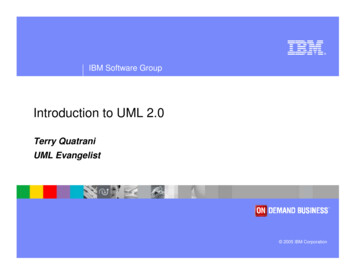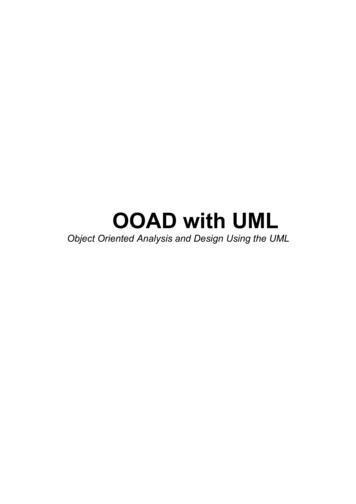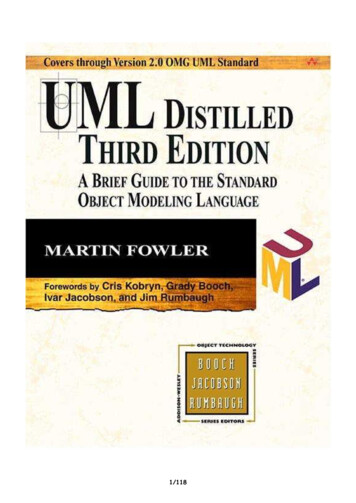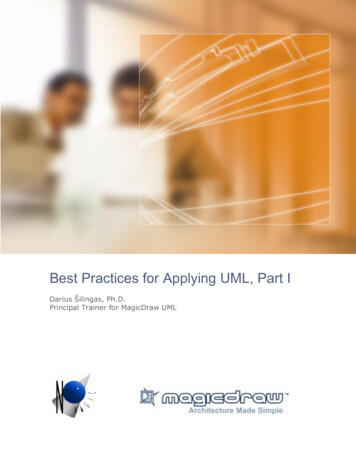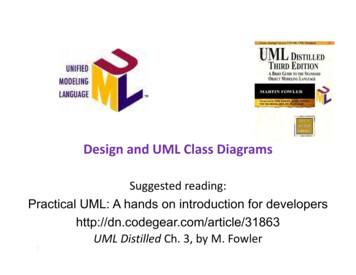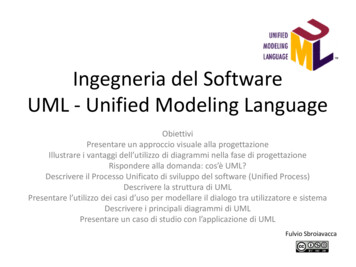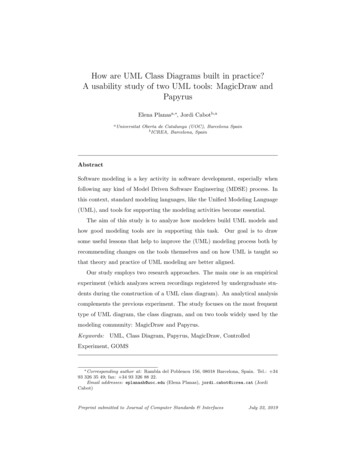
Transcription
01-Introduction.fm Page 1 Wednesday, April 17, 2002 4:33 PM1IntroductionOrganizations want systems. They don’t want processes, meetings, models, documents, or even code.1 They want systems that work—as quicklyas possible, as cheaply as possible, and as easy to change as possible.Organizations don’t want long software development lead-times and highcosts; they just want to reduce systems development hassles to the absolute minimum.But systems development is a complicated business. It demands distillation of overlapping and contradictory requirements; invention of goodabstractions from those requirements; fabrication of an efficient, costeffective implementation; and clever solutions to isolated coding andabstraction problems. And we need to manage all this work to a successfulconclusion, all at the lowest possible cost in time and money.None of this is new. Over thirty years ago, the U.S. Department of Defensewarned of a “software crisis” and predicted that to meet the burgeoningneed for software by the end of the century, everyone in the country wouldhave to become a programmer. In many ways this prediction has cometrue, as anyone who has checked on the progress of a flight or made astock trade using the Internet can tell you. Nowadays, we all write our own1Robert Block began his book The Politics of Projects[1] in a similar manner.1
01-Introduction.fm Page 2 Wednesday, April 17, 2002 4:33 PM2INTRODUCTIONprograms by filling in forms—at the level of abstraction of the application,not the software.1.1Raising the Level of AbstractionThe history of software development is a history of raising the level ofabstraction. Our industry used to build systems by soldering wirestogether to form hard-wired programs. Machine code allowed us to storeprograms by manipulating switches to enter each instruction. Data wasstored on drums whose rotation time had to be taken into account so thatthe head would be able to read the next instruction at exactly the righttime. Later, assemblers took on the tedious task of generating sequencesof ones and zeroes from a set of mnemonics designed for each hardwareplatform.Later, programming languages, such as FORTRAN, were born and “formula translation” became a reality. Standards for COBOL and C enabledportability between hardware platforms, and the profession developedtechniques for structuring programs so that they were easier to write,understand, and maintain. We now have languages such as Smalltalk,C , Eiffel, and Java, each with the notion of object-orientation, anapproach for structuring data and behavior together into classes andobjects.As we moved from one language to another, generally we increased thelevel of abstraction at which the developer operates, requiring the developer to learn a new higher-level language that may then be mapped intolower-level ones, from C to C to assembly code to machine code and thehardware. At first, each higher layer of abstraction was introduced only asa concept. The first assembly languages were no doubt invented withoutthe benefit of an (automated) assembler to turn the mnemonics into bits,and developers were grouping functions together with the data theyencapsulated long before there was any automatic enforcement of theconcept. Similarly, the concepts of structured programming were taughtbefore there were structured programming languages in widespreadindustrial use (pace, Pascal).
01-Introduction.fm Page 3 Wednesday, April 17, 2002 4:33 PMRAISING THE LEVEL OF ABSTRACTION3Layers of Abstraction and the MarketThe manner in which each higher layer of abstraction reached the market follows a pattern. The typical response to the introduction of the next layer ofabstraction goes something like this: “Formula translation is a neat trick, buteven if you can demonstrate it with an example, it couldn’t possibly work on aproblem as complex and intricate as mine.”As the tools became more useful and their value became more obvious, a wholenew set of hurdles presented themselves as technical folk tried to acquire thewherewithal to purchase the tools. Now managers wanted to know what wouldhappen if they came to rely on these new tools. How many vendors are there?Are other people doing this? Why should we take the risk in being first? Whathappens if the compiler builder runs out of business? Are we becoming toodependent on a single vendor? Are there standards? Is there interchange?Initially, it must be said, compilers generated inefficient code. The developmentenvironment, as one would expect, comprised a few, barely production-leveltools. These were generally difficult to use, in part because the producers of thetools focused first on bringing the technology to market to hook early adopters,and later on prettier user interfaces to broaden that market. The tools did notnecessarily integrate with one another. When programs went wrong, no supporting tools were available: No symbolic debuggers, no performance profilingtools, no help, really, other than looking at the generated code, which surelydefeated the whole purpose.Executable UML and the tooling necessary to compile and debug an executableUML model are only now passing from this stage, so expect some resistancetoday and much better tools tomorrow.But over time the new layers of abstraction became formalized, and toolssuch as assemblers, preprocessors, and compilers were constructed tosupport the concepts. This has the effect of hiding the details of the lowerlayers so that only a few experts (compiler writers, for example) need concern themselves with the details of how that layer works. In turn, thisraises concerns about the loss of control induced by, for example, eliminating the GOTO statement or writing in a high-level language at a distance from the “real machine.” Indeed, sometimes the next level ofabstraction has been too big a reach for the profession as a whole, of interest to academics and purists, and the concepts did not take a large enoughmindshare to survive. (ALGOL-68 springs to mind. So does Eiffel, but it hastoo many living supporters to be a safe choice of example.)
01-Introduction.fm Page 4 Wednesday, April 17, 2002 4:33 PM4INTRODUCTIONObject Method HistoryObject methods have a complex history because they derive from two very different sources.One source is the programming world, whence object-oriented programmingcame. Generalizing shamelessly, object-oriented programmers with an interestin methods were frustrated with the extremely process-oriented perspective of“structured methods” of the time. These methods, Structured Analysis andStructured Design, took functions as their primary view of the system, andviewed data as a subsidiary, slightly annoying, poor relation. Even the “realtime” methods at most just added state machines to the mix to control processing, and didn’t encapsulate at all. There was a separate “Information Modeling”movement that was less prominent and which viewed data as all, and processing as a nuisance to be tolerated in the form of CRUD . Either way, both ofthese camps completely missed the object-oriented boat. To add insult toinjury, one motivation for objects—the notion that an object modeled the realworld, and then seamlessly became the software object—was prominently violated by the emphasis in transforming from one (analysis) notation, data flowdiagrams, to another (design) notation, the structure chart.Be that as it may, the search was on for a higher level of abstraction than theprogramming language, even though some claimed that common third-generation programming languages such as Smalltalk had already raised the level ofabstraction far enough.The other source was more centered in analysis. These approaches focused onmodeling the concepts in the problem, but in an object-oriented way. Classescould be viewed as combinations of data, state, and behavior at a conceptuallevel only. In addition to the model, reorganization of “analysis” classes into“design” classes, and re-allocation of functionality were expected. There was noneed to model the specific features used from a programming languagebecause the programmer was to fill in these details. Perhaps the purest proponents of this point of view were Shlaer and Mellor. They asserted classes withattributes clearly visible on the class icon seemingly violating encapsulation,with the full expectation that object-oriented programming schemes wouldselect an appropriate private data structure with the necessary operations.These two sources met in the middle to yield a plethora of methods, each withits own notation (at least 30 published), each trying to some extent to meet theneeds of both camps. Thus began the Method Wars, though Notation Warsmight be more accurate.UML is the product of the Method Wars. It uses notations and ideas from manyof the methods extant in the early nineties, sometimes at different levels ofabstraction and detail.
01-Introduction.fm Page 5 Wednesday, April 17, 2002 4:33 PMEXECUTABLE UML5As the profession has raised the level of abstraction at which developerswork, we have developed tools to map from one layer to the next automatically. Developers now write in a high-level language that can be mappedto a lower-level language automatically, instead of writing in the lowerlevel language that can be mapped to assembly language, just as our predecessors wrote in assembly language and translated that automaticallyinto machine language.Clearly, this forms a pattern: We formalize our knowledge of an application in as high a level language as we can. Over time, we learn how to usethis language and apply a set of conventions for its use. These conventionsbecome formalized and a higher-level language is born that is mappedautomatically into the lower-level language. In turn, this next-higher-levellanguage is perceived as low level, and we develop a set of conventions forits use. These newer conventions are then formalized and mapped intothe next level down, and so on.1.2Executable UMLExecutable UML is at the next higher layer of abstraction, abstractingaway both specific programming languages and decisions about the organization of the software so that a specification built in Executable UMLcan be deployed in various software environments without change.Physically, an Executable UML specification comprises a set of modelsrepresented as diagrams that describe and define the conceptualizationand behavior of the real or hypothetical world under study. The set ofmodels, taken together, comprise a single specification that we can examine from several points of view. There are three fundamental projectionson the specification, though we may choose to build any number of UMLdiagrams to examine the specification in particular ways.The first model identifies, classifies, and abstracts the real or hypotheticalworld under study, and it organizes the information into a formal structure. Similar “things,” or objects, in the subject matter under study areidentified and abstracted as classes; characteristics of these objects areabstracted as attributes; and reliable associations between the objects areabstracted as relationships.
01-Introduction.fm Page 6 Wednesday, April 17, 2002 4:33 PM6INTRODUCTIONConceptCalledModeled AsExpressed AsdataclassesattributesassociationsconstraintsUML class diagramthings uresUML statechart diagramthings do things ateach stagealgorithmactionsaction languagethe worldis full of thingsFigure 1.1Concepts in an Executable UML ModelOperations do not appear explicitly as entries in Figure 1.1 because Executable UML derives operations from actions on state machines.Invoked actions may be shown as operations on classes, but their existenceis normally dependent on the invocation that occurs in a state machine.We express this first model using a UML class diagram. The abstractionprocess requires that each object be subject to and conform to the welldefined and explicitly stated rules or policies of the subject matter understudy, that attributes be abstractions of characteristics of things in thesubject matter under study, and that relationships similarly model associations in the subject matter.Next, the objects (the instances of the classes) may have lifecycles (behaviors over time) that are abstracted as state machines. These statemachines are defined for classes, and expressed using a UML statechartdiagram. The abstraction process requires that each object be subject toand conform to the well-defined and explicitly stated rules or policies ofthe world under study, so each object is known to exhibit the same patternof behavior.The behavior of the system is driven by objects moving from one stage intheir lifecycles to another in response to events. When an object changes
01-Introduction.fm Page 7 Wednesday, April 17, 2002 4:33 PMMAKING UML EXECUTABLE7Executable UML is a single language in the UML family, designed for a singlepurpose: to define the semantics of subject matters precisely. ExecutableUML is a particular usage, or profile, the formal manner in which we specifya set of rules for how particular elements in UML fit together for a particularpurpose.This book, then, describes a profile of UML for execution.state, something must happen to make this new state be so. Each statemachine has a set of procedures, one of which is executed when the objectchanges state, thus establishing the new state.Each procedure comprises a set of actions. Actions carry out the fundamental computation in the system, and each action is a primitive unit ofcomputation, such as a data access, a selection, or a loop. The UML onlyrecently defined a semantics for actions, and it currently has no standardnotation or syntax, though several (near-)conforming languages are available.These three models—the class model, the state machines for the classes,and the states’ procedures—form a complete definition of the subjectmatter under study. Figure 1.1 describes the concepts in an ExecutableUML model.In this book we will informally make use of other UML diagrams, such asuse case and collaboration diagrams, that support the construction of executable UML models or can be derived from them. We encourage usingany modeling technique, UML-based or otherwise, that helps build thesystem.1.3Making UML ExecutableEarlier versions of UML were not executable; they provided for anextremely limited set of actions (sending a signal, creating an object,destroying an object, as well as our personal favorite, “uninterpretedstring”). In late 2001, the UML was extended by a semantics for actions.The action semantics provides a complete set of actions at a high level ofabstraction. For example, actions are defined for manipulating collections
01-Introduction.fm Page 8 Wednesday, April 17, 2002 4:33 PM8INTRODUCTION!Executable UML isn’t just a good idea, it’s real. There are several ExecutableUML vendors, and the models in this book have been executed to ensurethey are correct. The case study models and the toolset are downloadable.For the latest information on executable UML, go tohttp://www.executableumlbook.com.of objects directly, thus avoiding the need for explicit programming ofloops and iterators. Executable UML relies on these new actions to becomplete.For UML to be executable, we must have rules that define the dynamicsemantics of the specification. Dynamically, each object is thought of asexecuting concurrently, asynchronously with respect to all others. Eachobject may be executing a procedure or waiting for something to happento cause it to execute. Sequence is defined for each object separately; thereis no global time and any required synchronization between objects mustbe modeled explicitly.The existence of a defined dynamic semantics makes the three modelscomputationally complete. A specification can therefore be executed, verified, and translated into implementation.Executable UML is designed to produce a comprehensive and comprehensible model of a solution without making decisions about the organization of the software implementation. It is a highly abstract thinking toolto aid in the formalization of knowledge, a way of thinking about anddescribing the concepts that make up an abstract solution to a clientproblem.Executable UML helps us work out how we want to think about a solution:the terms we need to define, the assumptions we make in selecting thoseterms, and the consistency of our definitions and assumptions. In addition, executable UML models are separate from any implementation, yetcan readily be executed to test for completeness and correctness.Most important of all, together with a model compiler, they are executable.
01-Introduction.fm Page 9 Wednesday, April 17, 2002 4:33 PMMODEL COMPILERS1.49Model CompilersAt some level, it is fair to say that any language that can be executed is necessarily a programming language; it’s just a matter of the level of abstraction. So, is executable UML yet another (graphical) programminglanguage?An executable UML model completely specifies the semantics of a singlesubject matter, and in that sense, it is indeed a “program” for that subjectmatter. There is no magic. Yet an executable UML model does not specifymany of the elements we normally associate with programming today. Forexample, an executable UML model does not specify distribution; it doesnot specify the number and allocation of separate threads; it does notspecify the organization of data; it does not even require implementationas classes and objects. All of these matters are considered decisions thatrelate to hardware and software organization, and they have no place in amodel concerned with, say, the purchase of books online.Decisions about the organization of the hardware and software areabstracted away in an executable UML model, just as decisions about register allocation and stack/heap organization are abstracted away in thetypical compiler. And, just as a typical language compiler makes decisionsabout register allocation and the like for a specific machine environment,so does an executable UML model compiler make decisions about a particular hardware and software environment, deciding, for example, to usea distributed Internet model with separate threads for each user window,HTML for the user interface displays, and so on.An executable UML model compiler turns an executable UML model intoan implementation using a set of decisions about the target hardware andsoftware environment.There are many possible executable UML model compilers for differentsystem architectures. Each architecture makes its own decisions about theorganization of hardware and software, including even the programminglanguage. Each model compiler can compile any executable UML modelinto an implementation.
01-Introduction.fm Page 10 Wednesday, April 17, 2002 4:33 PM10INTRODUCTIONThe notion of so many different model compilers for such different softwarearchitecture designs is a far cry from the one-size-fits-all visual modelingtools of the past.!Here are some examples of possible model compilers:1.2.3.4.5.6.7.8.Multi-tasking C optimized for embedded systems, targeting Windows, Solaris, and various real-time operating systems. [3]Multi-processing C with transaction safety and rollback. [2]Fault-tolerant, multi-processing C with persistence supportingthree processor types and two operating systems.C straight on to an embedded system, with no operating system. [3]C , widely distributed discrete-event simulation, Windows, andUNIX.Java byte code for single-tasking Java with EJB session beans and XMLinterfaces.Handel-C and C for system-level hardware/software development.A directly executing executable UML virtual machine.A single model compiler may employ several languages or approaches toproblems such as persistence and multi-tasking. Then, however, the several approaches must be shown to fit together into a single, coherentwhole.Of these, some are commercially available, as indicated by the referencesprovided above, and some are proprietary, built specifically to optimize aproperty found in related systems produced by a company, such as thefault-tolerant multi-processing model compiler. Some are still just prototypes or twinkles in our eyes, such as the last three.As a developer, you will build an executable UML model that capturesyour solution for the subject matter under study, purchase a model compiler that meets the performance properties and system characteristicsyou require, and give directives to the compiler for the particular application. Hence, a system that must control a small robot would select thesmall footprint C model compiler or one like it, and a system executing
01-Introduction.fm Page 11 Wednesday, April 17, 2002 4:33 PMMODEL-DRIVEN ARCHITECTURE11financial transactions would prefer one with transaction safety and rollback.The performance of the model compiler may depend on the allocations ofapplication model elements, and a model compiler may not know enoughto be able to allocate a particular class to that task or processor for the bestperformance. Similarly, a model compiler that provides persistence maynot know enough about your subject matter to determine what to makepersistent. Consequently, you will also need to provide model compiler–specific configuration information. Each feature provided by the modelcompiler that does not have a direct analog in executable UML willrequire directives to determine which feature to use.These choices will affect performance of the model compiler. One particularly performance-sensitive feature is static allocation to tasks and processors. Allocating two classes that communicate heavily with differentprocessors could cause significant degradation of network performanceand of your system. If this is so, of course, it’s a simple matter to re-allocate the elements of the model and recompile. This is why executableUML is so powerful—by separating the model of the subject matter fromits software structure, the two aspects can be changed independently,making it easier to modify one without adversely affecting the other. Thisextends the Java notion of the “write once, run anywhere” concept; as weraise the level of abstraction, we also make our programs more portable. Italso enables a number of interesting possibilities for hardware-softwareco-design.1.5Model-Driven ArchitectureExecutable UML is one pillar supporting the Model-Driven Architecture(MDA) initiative announced by the Object Management Group (OMG) inearly 2001, the purpose of which is to enable specification of systemsusing models.Model-driven architecture depends on the notion of a Platform-Independent Model (PIM), a model of a solution to a problem that does not rely onany implementation technologies. A PIM is independent of its platform(s).
01-Introduction.fm Page 12 Wednesday, April 17, 2002 4:33 PM12INTRODUCTIONA model of a online bookstore, for example, is independent of the userinterface and messaging services it employs.A PIM can be built using an executable UML.Some proponents of MDA hold that a specification of the interface in alanguage such as the OMG’s Interface Description Language (IDL), plussome constraints, is sufficient to specify without overspecifying. The viewsof these two camps are not contradictory, but complementary. There is notechnical reason why a PIM specified using an executable UML cannot bebridged to one specified in terms of interfaces and constraints. One is justa more complete version of the other.It is because an executable model is required as a way to specify PIMscompletely that we view an executable UML as a foundation of modeldriven architectures.MDA also defines the concept of a Platform-Specific Model (PSM): amodel that contains within it the details of the implementation, enoughthat code can be generated from it. A PSM is produced by weavingtogether the application model and the platforms on which it relies. ThePSM contains information about software structure, enough information,possibly, to be able to generate code. Executable UML views the PSM as anintermediate graphical form of the code that is dispensable in the case ofcomplete code generation.At the time of writing, MDA is still being defined. However, some variationof the concepts of executable UML will, in our opinion, be required to support MDA. We offer our view on executable UML concepts here. Describing and defining MDA is another project and another book.1.6References[1] Block, Robert: The Politics of Projects. Yourdon Press, New York, NY,1983.[2] Kabira Technologies URL: www.kabira.com[3] Project Technology, Inc. URL: www.projtech.com
C , Eiffel, and Java, each with the notion of object-orientation, an approach for structuring data and behavior together into classes and objects. As we moved from one language to another, generally we increased the level of abstraction at which the developer operates, requiring the devel-
